1996 PONTIAC PONTIAC stop start
[x] Cancel search: stop startPage 79 of 370
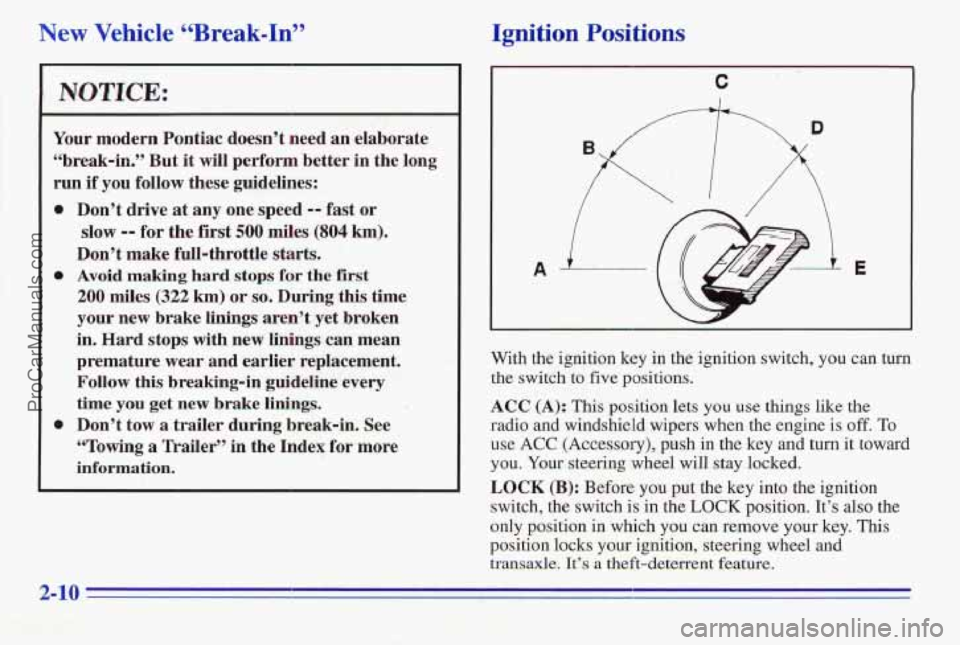
New Vehicle 66Break-InS’ Ignition Positions
Your modern Pontiac doesn’t need an elaborate
“break-in.” But
it will perform better in the long
run
if you follow these guidelines:
Don’t drive at any one speed
-- fast or
slow
-- for the first 500 miles (804 km).
Don’t make full-throttle starts.
Avoid making hard stops for the first
200 miles (322 km) or so. During this time
your new brake linings aren’t
yet broken
in. Hard stops with new linings can mean
premature wear and earlier replacement.
Follow this breaking-in guideline every
time
you get new brake linings.
Don’t tow a trailer during break-in, See
‘‘Towing a Trailer’’ in the Index for more
information.
C
A i E
With the ignition key in the ignition switch, you can twn
the switch to five positions.
ACC (A): This position lets you use things like the
radio and windshield wipers when the engine is
off. To
use ACC (Accessory), push in the key and turn it toward
you. Your steering wheel will stay locked.
LOCK (B): Before you put the key into the ignition
switch, the switch
is in the LOCK position. It’s also the
only position in which you can remove your key.
This
position locks your ignition, steering wheel and
transaxle. It’s a theft-deterrent feature.
ProCarManuals.com
Page 80 of 370
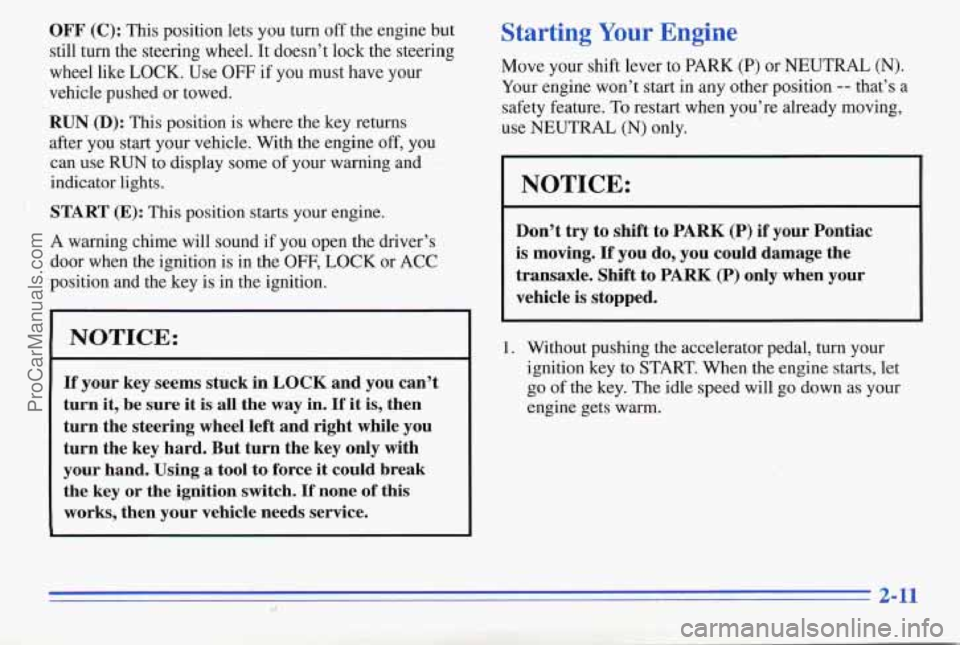
OFF (C): This position lets you turn off the engine but
still tuin the steering wheel. It doesn’t lock the steering
wheel like
LOCK. Use OFF if you must have your
vehcle pushed
or towed.
RUN (D): This position is where the key returns
after you start your vehicle. With the engine
off, you
can use
RUN to display some of your warning and
indicator lights.
: START (E): This position starts your engine.
A warning chime will sound
if you open the driver’s
door when the ignition is in the
OFF, LOCK or ACC
position and the key
is in the ignition.
NOTICE:
If your key seems stuck in LOCK and you can’t
turn it, be sure it
is all the way in. If it is, then
turn the steering wheel left and right while you
turn the key hard. But turn the key only with
your hand. Using
a tool to force it could break
the key or the ignition switch.
If none of this
works, then your vehicle needs service.
Starting Your Engine
Move your shift lever to PARK (P) or NEUTRAL (N).
Your engine won’t start in any other position -- that’s a
safety feature.
To restart when you’re already moving,
use
NEUTRAL (N) only.
NOTICE:
Don’t try to shift to PARK (P) if‘ your Pontiac
is moving.
If you do, you could damage the
transaxle. Shift to PARK
(P) only when your
vehicle is stopped.
1. Without pushing the accelerator pedal, turn your
ignition key
to START. When the engine starts, let
go of the key. The idle speed will go down as your
engine gets warm.
2-11
ProCarManuals.com
Page 81 of 370

NOTICE:
Hdding your key in START for longer than
15 seconds at a time will cause your battery to be
drained much sooner. And the excessive heat can
damage your starter motor.
2. If your engine won’t start (or starts but then stops),
it could be flooded with too
much gasoline. Try
pushing your accelerator pedal all the way to the
floor and holding it there as you hold the key in
START for up to 15 seconds. This clears the extra
gasoline from the engine.
4
NOTICE:
Your engine is designed to work with the
electronics in your vehicle.
If you add electrical
parts
or accessories, you could change the way
the engine operates. Before adding electrical
equipment, check with
your dealer. If you don’t,
your engine might not perform properly.
If’ you ever have to have your vehicle towed, see
the part
of this manual that tells how to do it
without damaging your vehicle. See “Towing
Your Vehicle” in the Index.
2-12
ProCarManuals.com
Page 84 of 370
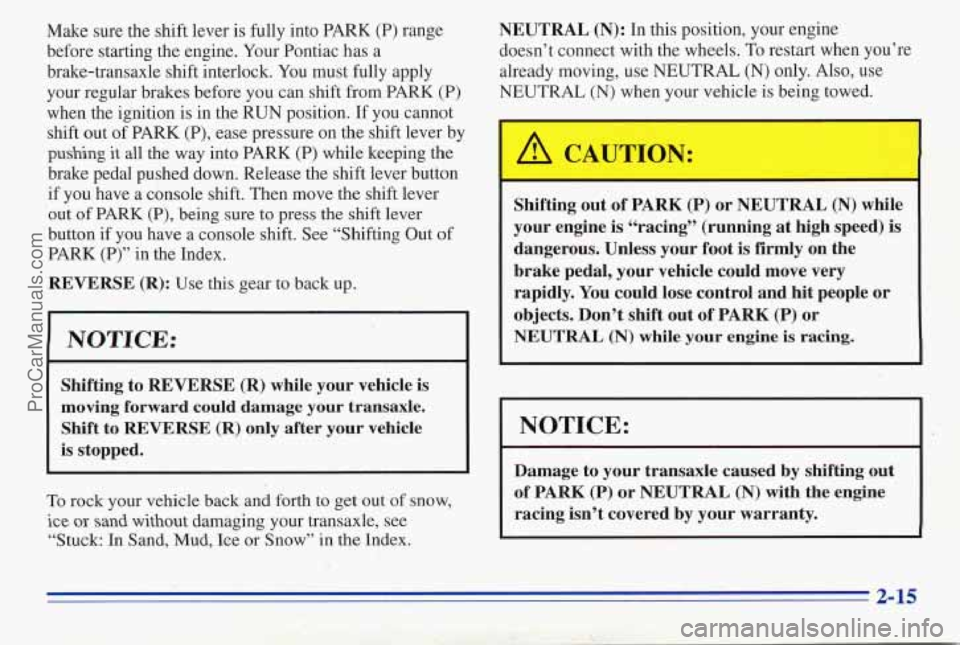
Make sure the shift lever is fully into PARK (P) range
before starting the engine. Your Pontiac has a
brake-transaxle shift interlock. You must fully apply
your regular brakes. before you can shift from PARK (P)
when the ignition is in the RUN position. If you cannot
shift out of PARK (P), ease pressure on the shift lever by
pushing it all the way into PARK (P) while keeping the
brake pedal pushed down. Release the shift lever button
if you have a console shift. Then move
the shift lever
out of PARK
(P), being sure to press the shift lever
button if you have a console shift. See “Shifting Out
of
PARK (P)” in the Index.
REVERSE (R): Use this gear to back up.
NOTICE:
.. .. ‘9: -. ~. - , . .. I. .,, :- . *.
Shifting to REVERSE (R) while your vehicle is
moving
forward could damage your transaxle.
Shift to REVERSE
(R) only after your vehicle
is stopped.
To rock your vehicle back and forth to get out of snow,
ice or sand without damaging your transaxle, see
“Stuck: In Sand,
Mud, Ice or Snow” in the Index.
NEUTRAL (N): In this position, your engine
doesn’t connect with the wheels. To restart when you’re
already moving, use NEUTRAL (N) only. Also, use
NEUTRAL (N) when your vehicle is being towed.
Shifting out of PARK (P) or NEUTRAL (N) while
your engine is “racing” (running
at high speed) is
dangerous. Unless your foot is firmly on the
brake pedal, your vehicle could move very
rapidly. You could lose control and hit people or
objects. Don’t shift out
of PARK (P) or
NEUTRAL (N) while your engine is racing.
NOTICE:
Damage,to your transaxle caused by shifting out
of PARK (P) or NEUTRAL (N) with the engine
racing isn’t covered by your warranty.
2-15
ProCarManuals.com
Page 97 of 370
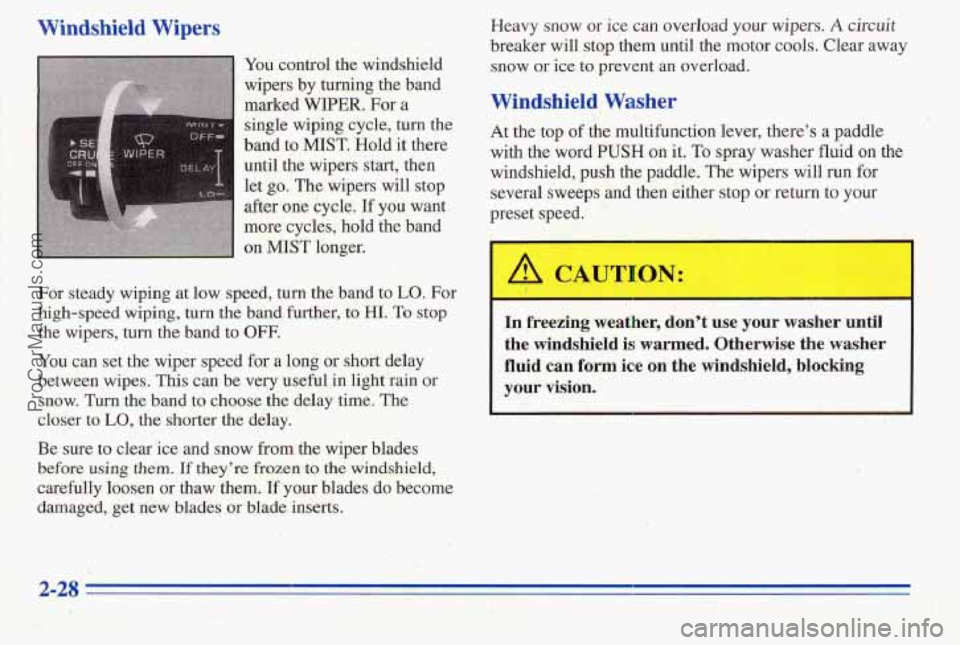
Windshield Wipers
You. control the windshield
wipers
by tuning the band
marked WIPER. Fora
single wiping cycle,
turn the
band to
MIST. Hold it there
until
the wipers start; then
let
go. The wipers will stop
dter-one cycle.
If you want.
more. cycles, hold the band
on
MIST longer.
For steady wiping at low speed, turn the band to LO. For
high-speed wiping, turn
the band’ further, to HI. To stop
You can set the wiper speed for a long or short delay
between wipes.
This can be very useful in light rain or
snow. Turn the band to choose the delay time. The
closer
to LO, the shorter the delay.
Be sure to clear ice and snow
from the wiper blades
before using th&n. If they’re Frozen,to the windshield,
carefully loosen or thaw them. If your blades do become
damaged, get new blades or blade inserts.
the wipers, turn the band to OW.
Heavy snow or ice can overload your wipers. A circuit
breaker will stop them until the motor cools. Clear away
snow
or ice to prevent an overload.
Windshield Washer
At he top of the multifunction lever, there’s a paddle
with the word
PUSH on it. To spray washer fluid on the
windshield,
push the paddle. The wipers will run far
several sweeps and then either stop
or return to your
preset speed.
,
I
In freezing weatll=r, don’t use your washer until
the
windshield is warmed. Otherwise the washer
fluid can form ice on the windshield, blocking
your
vision.
ProCarManuals.com
Page 109 of 370
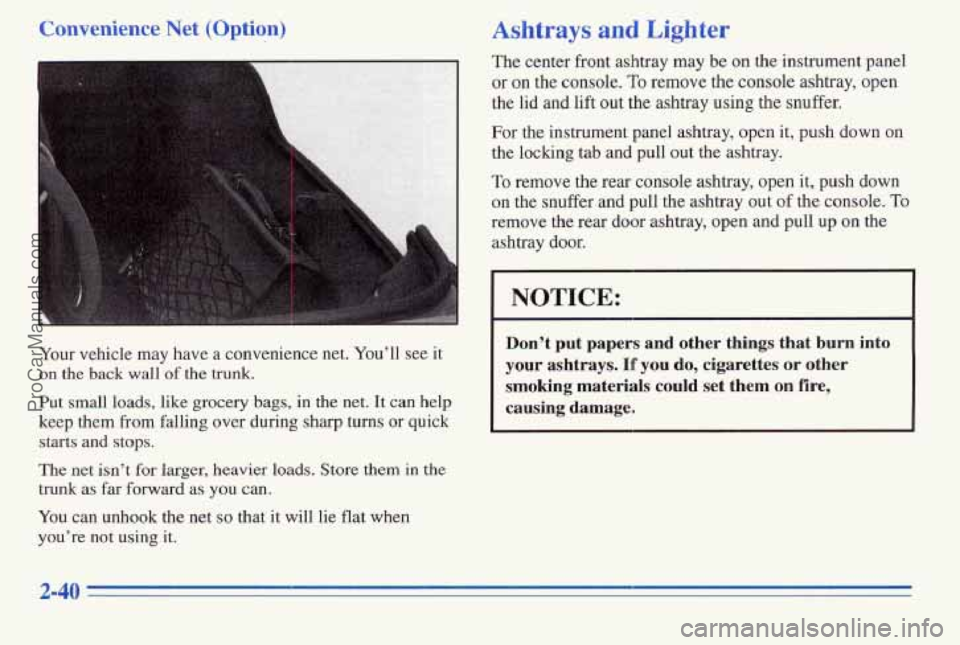
Convenience Net (Option)
Your vehicle may have a convenience net. You’ll see it
on
the back wall of the trunk.
Put small loads, like grocery bags, in the net. It can help
keep them from falling
over during sharp turns or quick
starts and
stops.
The net isn’t for larger, heavier loads. Store them in the
trunk as far forward as you can.
You can unhook the net so that it will lie flat when
you’re
not using it.
Ashtrays and Lighter
The center front ashtray may be on the instrument panel
or on the console. To remove the console ashtray, open
the lid and lift out the ashtray using the snuffer.
For the instrument panel ashtray, open it, push down on
the locking tab and pull out the ashtray.
To remove the rear console ashtray, open it, push down
on the snuffer and pull the ashtray out of the console. To
remove the rear door ashtray, open and pull up on the
ashtray
door.
NOTICE:
Don’t put papers and other things that burn into
your ashtrays.
If you do, cigarettes or other
smoking materials could set them
on fire,
causing damage,
ProCarManuals.com
Page 118 of 370
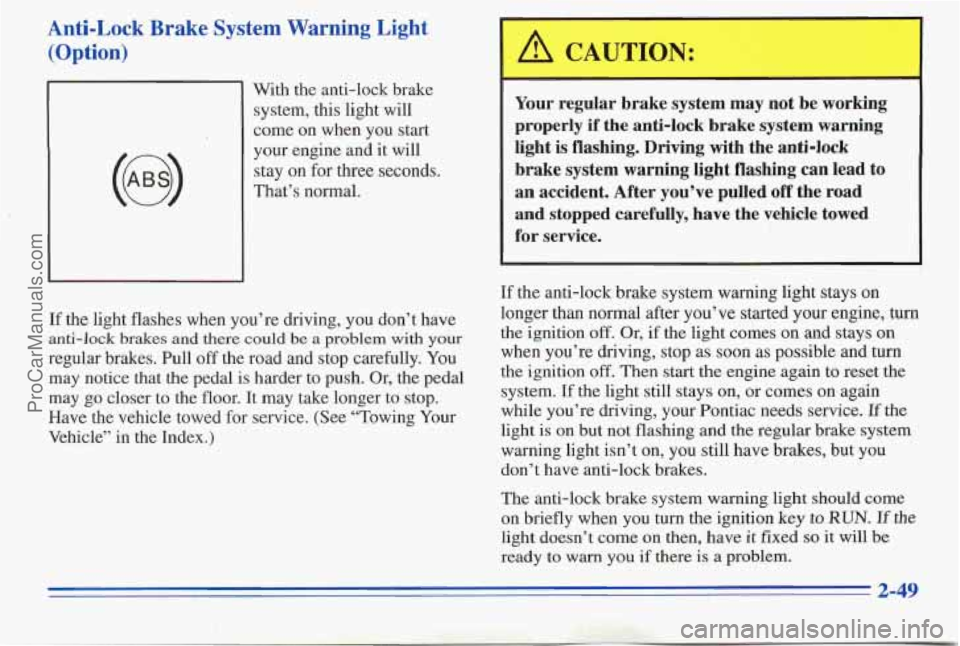
Anti-Lock Brake System Warning Light (Option)
(@)
With the anti-lock brake
system, this light will
come on when you start
your engine and it will
stay
on for three seconds.
That’s normal.
If the light flashes when you’re ( ving, you don’t have
anti-lock brakes and there could be a problem with your
regular brakes. Pull off the road and stop carefully.
You
may notice that the pedal is harder to push. Or, the pedal
may
go closer to the floor. It may take longer to stop.
Have the vehicle towed for service. (See ‘Towing Your
Vehicle’’ in the Index.)
A CAUTION:
I
Your regular brake system may not be working
properly if the anti-lock brake system warning
light is flashing. Driving with the anti-lock
brake system warning light flashing can lead to
an accident. After you’ve pulled
off the road
and stopped carefully, have the vehicle towed
for service.
If the anti-lock brake system warning light stays on
longer than normal after you’ve started your engine, turn
the ignition
off. Or, if the light comes on and stays on
when you’re driving, stop as soon as possible and turn
the ignition
off. Then start the engine again to reset the
system.
If the light still stays on, or comes on again
while you’re driving, your Pontiac needs service.
If the
light
is on but not flashing and the regular brake system
warning light isn’t on, you still have brakes, but you
don’t have anti-lock brakes.
The anti-lock brake system warning light should come
on briefly when you turn
the ignition key to RUN. If the
light doesn’t come on then, have it fixed so it will be
ready to
warn you if there is a problem.
ProCarManuals.com
Page 122 of 370

If the Light Is Flashing
The following may prevent more serious damage to
your vehicle:
If the Light Is On Steady
0 Reduce vehicle speed.
0 Avoid hard accelerations.
0 Avoid steep uphill grades.
0 If towing a trailer, reduce the amount of cargo ,being
hauled as soon as it is possible.
If the light stops flashing and remains
on steady, see “If
the Light Is On Steady” following.
If
the light continues to flash, when it is safe to do so,
stop the vehicle. Put your vehicle in PARK (P). Turn the
key off, wait at least 10 seconds and restart the engine.
If the light remains on steady, see “If the Light Is On
Steady” following.
If the light is still flashing, follow the
previous steps, and drive the vehicle to your dealer or
qualified service center for service.
You may be able to correct the emission system
malfunction by considering the following:
Did you just put fuel into your vehicle?
If
so, reinstall the fuel cap, making sure to fully install
the cap. The diagnostic system can determine if the fuel
cap has been left off or improperly installed.
This will
allow
fuel to evaporate into the atmosphere. A few
driving trips should turn the light off.
Did you just drive through a deep puddle of water?
If
so, your electrical system,.may be wet. The condition
will usually be corrected when the electrical system
dries out. A few driving trips should turn the light
off.
Are you low on fuel?
As your engine starts to
run out of fuel, your engine may
not run as efficiently as designed since
small amounts of
air are sucked into the fuel line causing a misfire. The
system can
detect this. Adding fuel should correct this
condition. Make sure to install the fuel cap properly. It
will take a few driving trips to turn the light off.
2-53
ProCarManuals.com